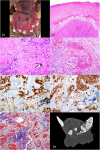Case Report: Amyloid-Producing Odontogenic Tumor With Pulmonary Metastasis in a Spinone Italiano-Proof of Malignant Potential
- PMID: 33134357
- PMCID: PMC7552887
- DOI: 10.3389/fvets.2020.576376
Case Report: Amyloid-Producing Odontogenic Tumor With Pulmonary Metastasis in a Spinone Italiano-Proof of Malignant Potential
Abstract
A 1-year-old male Spinone Italiano dog was treated for an amyloid-producing odontogenic tumor on the right maxilla with a cytoreductive surgery followed by a definitive radiation protocol. Six years later, the dog presented for a new mass on the rostral mandible as well as a lung nodule without recurrence of the original maxillary tumor. Both the mandibular mass and the lung nodule were histologically confirmed to be amyloid-producing odontogenic tumor based on the appearance of sheets and cords of the odontogenic epithelium disrupted by amorphous extracellular amyloid. This case illustrates the metastatic potential for amyloid-producing odontogenic tumor in dogs and asynchronous occurrence of multiple APOTs in the oral cavity.
Keywords: amyloid producing odontogenic tumor; dogs; neoplasia; odontogenic tumor; pathology—head and neck neoplasms.
Copyright © 2020 Blackford Winders, Bell and Goldschmidt.
Figures



References
Publication types
LinkOut - more resources
Full Text Sources

